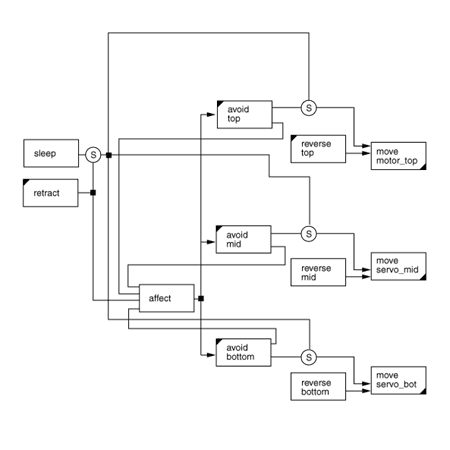|
overview
trundle
v1.2
anatomy
images
behavior
interaction
movement
trundle v1.1
anatomy
images
behavior
trundle v1.0
anatomy
images
|

Using social
language to describe the movement and interaction with Trundle, it can
be said that Trundle seeks attention, but is shy. It changes its mood
over time as a function of the amount of attention is receives. Mood
is communicated through posture and quality of movement. When Trundles
is first activated, its basic behavior is to seek out stimulus. This
is achieved through slowly moving laterally along its track and scanning
its sonars across the space. It first pans left to right with its sonars
and when it reaches the end of this check, it moves laterally for one
second and then begins to sweep the environment once more. When the
sculpture reaches the end of the track, it turns around and comes back.
When it receives a stimulus through its sonar, it quickly jerks away,
pauses, and begins to move leisurely once again.
In addition to
a series of simple reflexes, the activity of Trundle is dominated by
a number of absolute actions. These are analogous to the fixed action
patterns found in many animals. For example, when Trundle is touched,
it will quickly jerk away and collapse into its neutral state. It sets
all of its excitation variables to neutral and slowly begins to expand
the reach of its sensors, starting at the top and moving its way to
the bottom of the sculpture.
Trundle adapts
its behavior over time by changing internal state variables which affect
how the sculpture senses and moves. For example, if Trundle is constantly
registering stimulus in its sonar, it can begin to look for signals
at a closer range. This will either cause people to come closer or allow
it to ignore a large object brought into its vision. Trundle will also
have a concept of affect. Through continual interaction with the sculpture,
it may become excited and change the quality of its movements to become
increasingly rapid and short. If the sculpture suffers from neglect,
it will slow its movement down and occasionally lash out by thrashing
itself. The behavior of Trundle is implemented in C code as a series
of finite state machines. The original plan for the behavior architecture
is outlined in the diagram at the top of the page.
|

